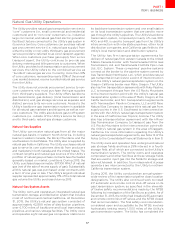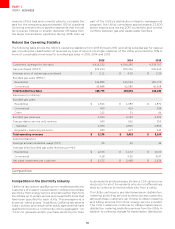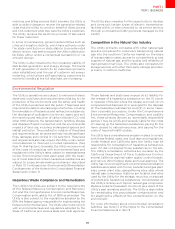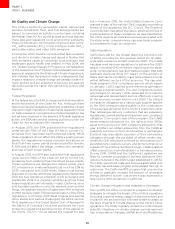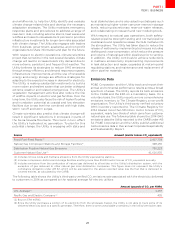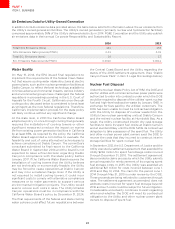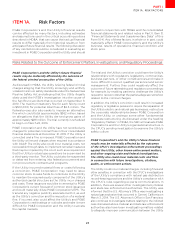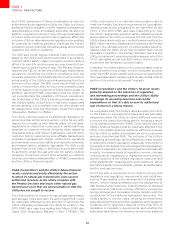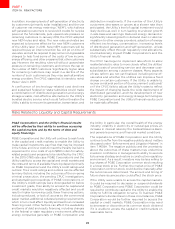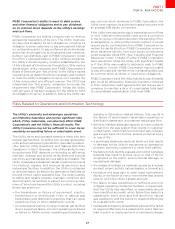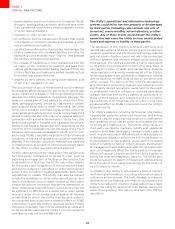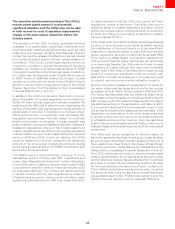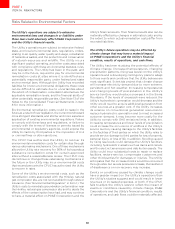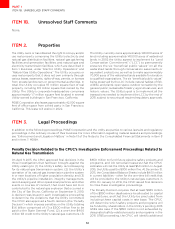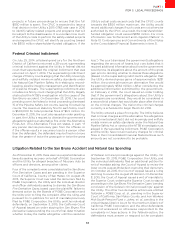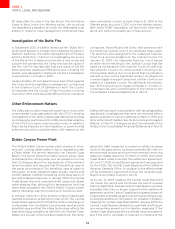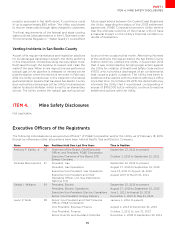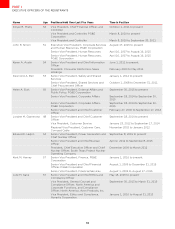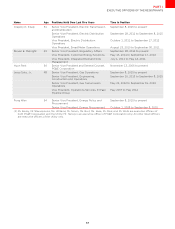PG&E 2015 Annual Report Download - page 35
Download and view the complete annual report
Please find page 35 of the 2015 PG&E annual report below. You can navigate through the pages in the report by either clicking on the pages listed below, or by using the keyword search tool below to find specific information within the annual report.
27
PART I
ITEM 1A.RISK FACTORS
PG&E Corporation’s ability to meet its debt service
and other financial obligations and to pay dividends
on its common stock depends on the Utility’s earnings
and cash flows.
PG&E Corporation is a holding company with no revenue
generating operations of its own. The Utility must use
its resources to satisfy its own obligations, including its
obligation to serve customers, to pay principal and interest
on outstanding debt, to pay preferred stock dividends,
and meet its obligations to employees and creditors,
before it can distribute cash to PG&E Corporation. Under
the CPUC’s rules applicable to utility holding companies,
the Utility’s dividend policy must be established by the
Utility’s Board of Directors as though the Utility were a
stand-alone utility company and PG&E Corporation’s
Board of Directors give “first priority” to the Utility’s capital
requirements, as determined to be necessary and prudent
to meet the Utility’s obligation to serve or to operate the
Utility in a prudent and ecient manner. The CPUC has
interpreted this “first priority” obligation to include the
requirement that PG&E Corporation “infuse the Utility
with all types of capital necessary for the Utility to fulfill
its obligation to serve.” In addition, before the Utility can
pay common stock dividends to PG&E Corporation, the
Utility must maintain its authorized capital structure with
an average 52% equity component.
If the Utility were required to pay a material amount of fines
or incur material unrecoverable costs due to a conviction
in the on-going criminal prosecution, the pending CPUC
investigations, or other enforcement matters, it would
require equity contributions from PG&E Corporation to
restore its capital structure. PG&E Corporation common
stock issuances used to fund such equity contributions
could materially dilute EPS. (See “Liquidity and Financial
Resources” in Item 7. MD&A.) Further, if PG&E Corporation
were required to infuse the Utility with significant capital
or if the Utility was unable to distribute cash to PG&E
Corporation, or both, PG&E Corporation may be unable
to pay principal and interest on its outstanding debt, pay
its common stock dividend, or meet other obligations.
PG&E Corporation’s and the Utility’s ability to pay dividends
also could be aected by financial covenants contained
in their respective credit agreements that require each
company to maintain a ratio of consolidated total debt
to consolidated capitalization of at most 65%.
Risks Related to Operations and Information Technology
The Utility’s electricity and natural gas operations
are inherently hazardous and involve significant risks
which, if they materialize, can adversely aect PG&E
Corporation’s and the Utility’s financial results. The
Utility’s insurance may not be sucient to cover losses
caused by an operating failure or catastrophic event.
The Utility owns and operates extensive electricity and
natural gas facilities, including two nuclear generation
units and an extensive hydroelectric generating system.
(See “Electric Utility Operations” and “Natural Gas Utility
Operations” in Item 1. Business.) The Utility’s ability to earn
its authorized ROE depends on its ability to eciently
maintain, operate, and protect its facilities, and provide
electricity and natural gas services safely and reliably. The
Utility undertakes substantial capital investment projects
to construct, replace, and improve its electricity and
natural gas facilities. In addition, the Utility is obligated
to decommission its electricity generation facilities at
the end of their useful operating lives. The Utility’s ability
to safely and reliably operate, maintain, construct and
decommission its facilities is subject to numerous risks,
many of which are beyond the Utility’s control, including
those that arise from:
đ
the breakdown or failure of equipment, electric
transmission or distribution lines, or natural gas
transmission and distribution pipelines, that can cause
explosions, fires, or other catastrophic events;
đ
an overpressure event occurring on natural gas facilities
due to equipment failure, incorrect operating procedures
or failure to follow correct operating procedures, or
welding or fabrication-related defects, that results in
the failure of downstream transmission pipelines or
distribution assets and uncontained natural gas flow;
đ
failure to maintain adequate capacity to meet customer
demand on the gas system that results in customer
curtailments, controlled/uncontrolled gas outages,
gas surges back into homes, serious personal injury
or loss of life;
đ
a prolonged statewide electrical black-out that results
in damage to the Utility’s equipment or damage to
property owned by customers or other third parties;
đ
the failure to fully identify, evaluate, and control workplace
hazards that result in serious injury or loss of life for
employees or the public, environmental damage, or
reputational damage;
đ
the release of radioactive materials caused by a nuclear
accident, seismic activity, natural disaster, or terrorist act;
đ the failure of a large dam or other major hydroelectric
facility, or the failure of one or more levees that protect
land on which the Utility’s assets are built;
đ
the failure to take expeditious or sucient action to
mitigate operating conditions, facilities, or equipment,
that the Utility has identified, or reasonably should
have identified, as unsafe, which failure then leads to a
catastrophic event (such as a wild land fire or natural
gas explosion), and the failure to respond eectively
to a catastrophic event;
đ
inadequate emergency preparedness plans and the failure
to respond eectively to a catastrophic event that can
lead to public or employee harm or extended outages;


